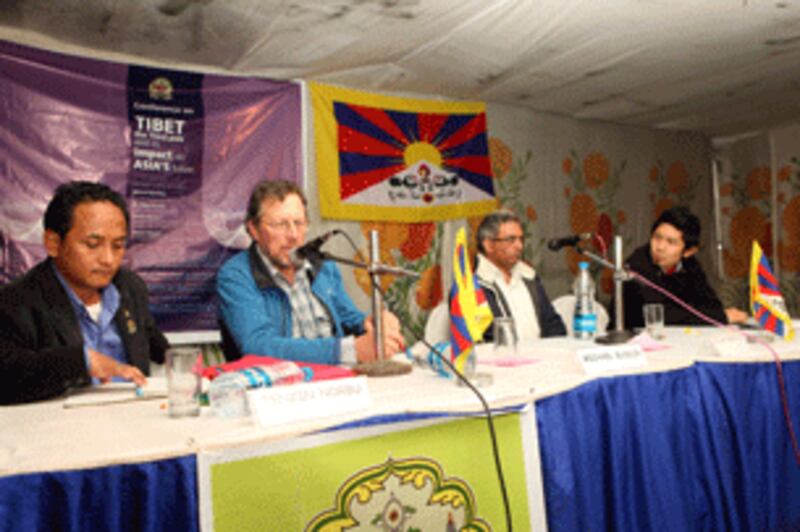China’s control and exploitation of Tibet’s natural resources is threatening the survival not just of the disputed territory but the whole of Asia, according to panelists at an environmental forum on the sidelines of a recent Tibetan Buddhist event in India.
At the discussion this week on “Tibet: The Third Pole and its Impact on Asia’s Future," experts presented photographs and videos showing, they said, how Chinese development is damaging Tibet’s pristine ecosystem.
“The preservation and management of Tibet, Asia’s water tower, will be one of the most critical issues of the 21st century,” said Indian photographer and Tibetologist Vijay Kranti at the event hosted by the Tibetan Women’s Association at the Dalai Lama's ancient Kalachakra ritual in Bodhgaya.
The Tibetan plateau’s 46,000 glaciers comprise the planet’s third-largest ice mass after the North and South Poles. And this “third pole” is the fount of Asia’s 10 largest rivers, the primary source of fresh water for 11 countries—a region whose population and industrial output are projected to double within 50 years.
Though precise figures are in dispute, some scientists predict that most Tibetan glaciers could vanish by 2350 if present levels of carbon gas emissions are not cut by 80 percent.
Kranti noted that in 2000, China launched its "Opening Up of the Western Regions," a huge development scheme to extract Tibet’s resources for Chinese industry.
“China has done this without consulting the nations of South and Southeast Asia. It is a looming catastrophe that is going underreported,” he said.
Pollution from mining

Tenzin Norbu, Head of Environment and Development for the Tibetan exile government in the north Indian hill town of Dharamsala, gave an overview of damage to Tibet’s permafrost, glaciers, and forests.
In 2006, Norbu said, China completed the Xizang railway, connecting the Tibetan capital Lhasa with Xining, the capital of China’s western Qinghai province. This railroad has now brought thousands of Chinese engineers into Tibet, and has facilitated the swift transport of minerals, stone, and lumber to China.
Noted travel writer and photographer Michael Buckley screened his documentary “Meltdown in Tibet.”
“Look what’s happening in the South China Sea,” Buckley said. “China is claiming it as its own. That’s how they view Tibet’s water.”
“In the 1990s, China refused to sign the U.N. treaty on transboundary rivers. China is also mining all over Tibet, polluting the rivers at their source.”
Buckley, who captured rare footage on his trips to Tibet, regularly updates his website www.meltdownintibet.com with news and satellite photographs of Chinese dam construction across the Tibetan plateau.
“You can see all of these dams on Google Earth,” Buckley said.
Asked what downstream nations can do to hold China accountable, Buckley said, “Aside from barring all trade with China, future scenarios look bleak. China owns Tibet, so China holds all the cards.”
Nomads resettled
Tenzin Dorjee, director of the New York-based Students for a Free Tibet, spoke about China’s resettlement of Tibetan nomads, noting that “many of the people who have come here [to Bodhgaya] from Tibet are nomads.”
“The nomads have been the stewards of [Tibet’s] grasslands for thousands of years, but the Chinese government is now saying that the nomads are the cause of ecological degradation, so they must be resettled into concrete encampments.”
“It is an excuse to make way for Chinese engineers to bring in Han migrant workers for mines and dams,” he said.
Tibet's pre-Buddhist Bon religion regards lakes and mountains as the sacred abodes of nature deities. Thus, mining and damming are not only viewed as offensive, but dangerous—they disturb the nagas, the snake spirits who rule lakes and rivers, and the ri-lhas, the mountain gods who rule the snow peaks.
Dorjee pointed to occasional victories, when local Tibetans blocked China’s mining of sacred mountains.
'Grey mountains, red rivers'
On the same day of the discussion Monday, Alo, an elderly Tibetan nomad from Kham with his hair tied into long braids and red tassels in the traditional style, sipped tea near Bodhgaya’s Mahabodhi Temple. He summoned memories of his childhood in the old Tibet.
“We [once] heard thunder and saw wild explosions in the sky,” he said. “Our local lama was crying.”
“We asked him what was happening, and he said there was a terrible war in the gods’ realm. The Chinese gods were winning and would soon seize Tibet.”
“Our lama told us that an oracle had said that if Chinese armies ever captured Tibet, the snow mountains would turn grey and the rivers would turn red.”
Tseten, another Khampa elder who fled to India during China’s Cultural Revolution, observed, “As long as the Tibet crisis is framed merely as a human rights issue, nothing will ever change.”
“The basic facts about Tibet’s size and natural resources are not well known, but when you show a map of the mines and dams all across Tibet, then people understand why Tibet matters.”
“There’s an old saying: He who controls Tibet controls the world.”
Reported by Maura Moynihan, a freelance correspondent.
